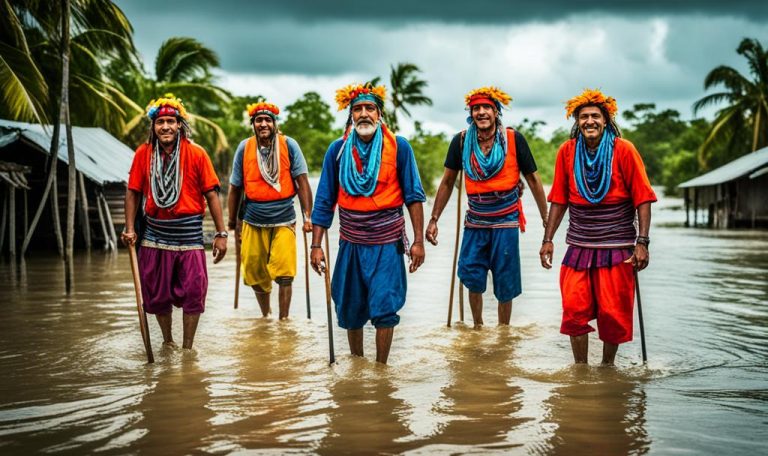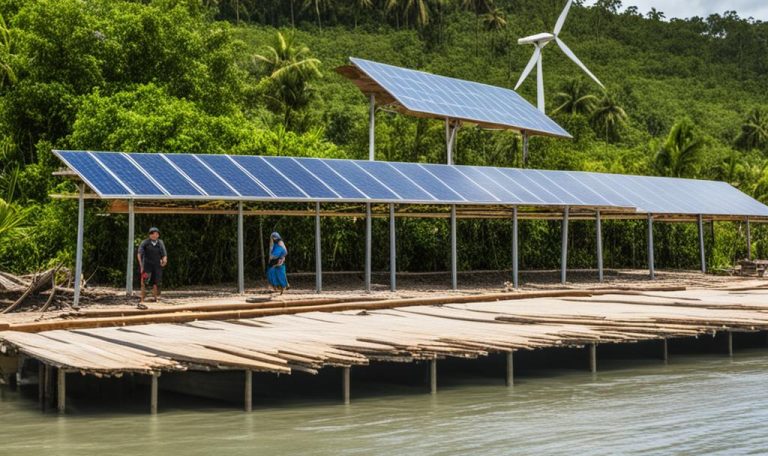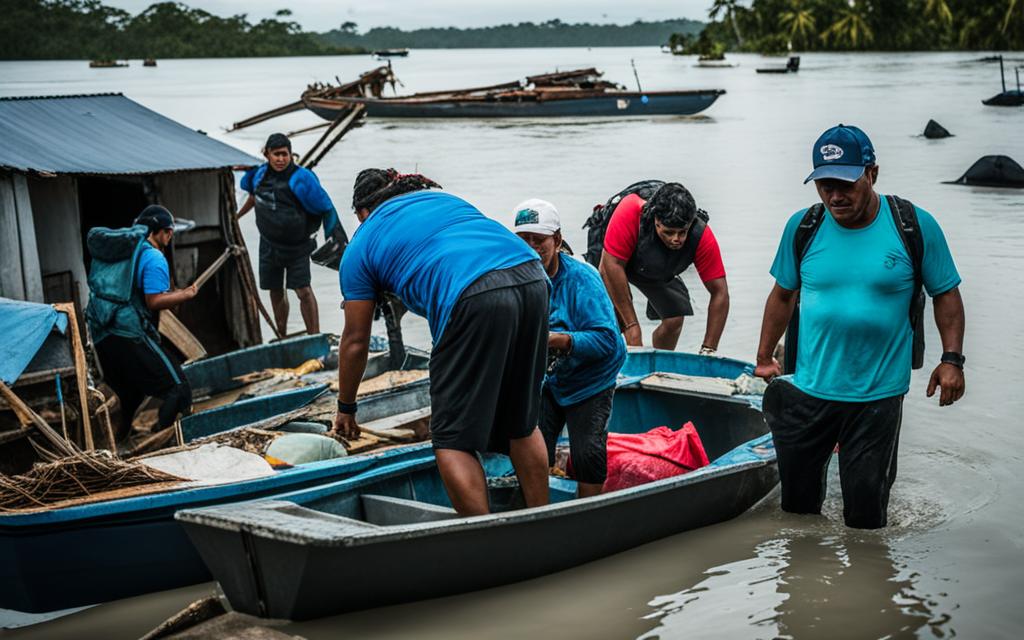The Panamanian government is stepping up to help the Guna people. They’re moving them from the sinking Cartí Sugdupu island to Nuevo Cartí. Climate change has made life hard for the community, forcing about 1,200 people to leave their homeland. The Guna have lived on this small island for a long time. It’s just the size of five football fields. This island is part of a large group of islands called Guna Yala. Many of these 365 islands are facing more flooding because of rising sea levels.
The new place, Nuevo Cartí, cost the government $12.2 million to build. It has about 300 homes on 14 hectares of land. Each house is an improvement, with two bedrooms, a living room, dining room, kitchen, bathroom, and laundry. They also have water and electricity. The government also made sure to add things that help keep the Guna’s culture alive. This includes facilities that show their traditions and way of life.
Key Takeaways
- The Panamanian government is relocating the indigenous Guna community from the sinking Cartí Sugdupu island to the new Nuevo Cartí development due to rising sea levels caused by climate change.
- The Nuevo Cartí development consists of around 300 houses built with a state investment of $12.2 million, providing the Guna community with improved housing, infrastructure, and access to essential services.
- The relocation aims to preserve the Guna’s cultural heritage by incorporating facilities related to their ethnic identity in the new community.
- The Guna people have lived in overcrowded conditions on the tiny, five-football-field-sized Cartí Sugdupu island, which is one of the 365 islands in the Guna Yala archipelago facing the threat of flooding.
- The relocation of the Guna community is the first instance of climate change-induced displacement in Panama, highlighting the growing global impact of rising sea levels on vulnerable coastal communities.
Panama Relocates Indigenous Community from Sinking Island
Climate Change Forces Relocation
The Panamanian government is moving the Guna community from Cartí Sugdupu. This island is sinking because of rising sea levels, a result of climate change. About 1,200 people will be relocated to Nuevo Cartí. This marks Panama’s first climate change relocation effort.
Guna Yala Indigenous People Affected
The Guna Yala people have lived in the San Blas archipelago for 170 years. They are now among millions worldwide facing the need to leave their homes. This is due to the rising sea levels caused by climate change.
Government Assistance for Relocation
The Panamanian government is helping the Guna people with their move. They’re offering better housing and other services. Thanks to a $12.2 million state investment, Nuevo Cartí will provide a new and improved life for the relocated community.
The Sinking Island of Cartí Sugdub
The Guna Yala community lives on the tiny island of Cartí Sugdub. Here, nearly 1,300 Indigenous Guna people make their home. The island is just about the size of five football fields.
It’s part of the Guna Yala territory, which sits on Panama’s northern coast. This area includes over 350 islands. These islands face a big problem due to their location and size.
Cartí Sugdub’s small size and low height above sea level put it in danger. Sea levels are rising and floods are becoming more common. The residents are trying to protect their homes. But, their efforts to keep out the ocean are not working well.
About eleven years ago, the Guna community realized they had to move. The island just can’t support its growing population safely anymore.
Rising Sea Levels Threaten Survival
Since the 1990s, the sea around Cartí Sugdub has been rising by 3.4mm every year. This rate has doubled since the 1960s. Scientists predict these levels will keep rising.
Across the Caribbean, sea levels are expected to rise even faster. By the end of the century, they could be going up by over a centimeter each year. The 365 islands of the San Blas archipelago are at risk, including Cartí Sugdub.
The Guna Yala people are in a race against time. They must find a new home to survive. This urgent change is essential for their future.
A New Beginning: Nuevo Cartí
The government of Panama has created Nuevo Cartí. It’s a community with 300 houses for the Guna Yala people. These houses are on the mainland, for those who had to leave the sinking Cartí Sugdupu island.
This move cost $12.2 million. The idea is to give the indigenous people better places to live. They faced problems like rising sea levels and too many people on their island.
Improved Housing and Infrastructure
Each house in Nuevo Cartí is about two bedrooms large. It has a living area, dining space, a kitchen, bathroom, and a place to do laundry. This means big changes in living for about 1,200 people moving from Cartí Sugdupu.
They get about 300 square meters of land with their house. This is for them to grow food, keeping alive their farming ways. The homes also have power all the time, clean water, and indoor bathrooms. This fixes a lot of the problems they had on the island.
Preserving Cultural Heritage
The government has made sure Nuevo Cartí includes places to keep the Guna Yala culture strong. Keeping the community’s traditions is key during this move. It helps keep the Guna’s culture alive every day.
Challenges of Transition
The change to Nuevo Cartí brings a lot of new opportunities. However, it’s not all easy. Being far from the sea might be hard for those used to fishing. Yet, the government and the Guna people together make a strong team. They are ready to face these hurdles and start anew in Nuevo Cartí.
The Guna People’s Resilience
The Guna Yala indigenous people have shown long-standing resilience. They fought for self-rule when the Spanish came to Colombia and Panama. They moved from the coast to Caribbean islands, creating Guna Yala in 1938. This change marked their strong will to keep their culture alive.
Historical Struggle for Autonomy
For many years, the Guna have faced and adapted to big changes. Their territory, Guna Yala, home to over 30,000 of them, includes islands and a bit of mainland. They’ve held this land since 1938. This fight for control and resilience have been key in the Guna’s story, building their core and helping them navigate today’s challenges.
Adapting to Change
The Guna faced another test with the move from Cartí Sugdupu to Nuevo Cartí due to rising sea levels. This is their response to climate change. They have responded by moving forward, showing strength to save their culture. They carry their rich past of resilience with them in this shift.

Global Impact of Climate Change
The Guna Yala relocation highlights the worldwide threat of rising sea levels due to climate change. This danger affects many people, especially those in Latin America and the Caribbean. The United Nations notes that 41 million individuals live in at-risk, low-lying areas in this region alone.
These communities face greater risks from floods, storm surges, and hurricanes. And these dangers grow as sea levels continue to rise.
Sea Level Rise Worldwide
In the Caribbean, sea levels are rising at a rapid pace, currently at 3-4 millimeters yearly. By the end of the century, experts worry this could jump to over 1 centimeter per year. This is double the current rate, putting places like the Guna Yala islands at serious risk.
Vulnerable Communities at Risk
By the century’s end, it’s estimated that hundreds of millions may need to leave their homes because of rising oceans. The Guna Yala indigenous community’s move shows how important it is to act quickly. They are a clear example of how climate change hits vulnerable people in coastal areas hard.
International Efforts and Responsibilities
The Guna Yala community is moving because of rising sea levels. This is linked to climate change. The Panama government wants rich countries to do more. They say these rich countries caused a lot of global warming. Panama asks these countries to help areas like Guna more.
Developed Countries’ Role in Emissions
The situation in Guna Yala shows we need to work together globally. Climate change affects the most vulnerable people, including the Guna. Countries that pollute the most should do something about it. They should help those hit hardest by climate change.
Honoring Climate Pledges
The Guna Yala people are facing higher sea levels. Panama wants all countries to keep their promises about fighting climate change. They need help to move safely. This crisis shows we need to all help each other, especially those most in need.
A Glimpse into the Future
The Guna Yala indigenous community is moving from Cartí Sugdupu island to mainland Nuevo Cartí. This move shows how communities might deal with climate-change-related moves in the future. The Panamanian government is helping these people protect their culture, live in better homes, and be part of the move.
Sustainable Relocation Strategies
Because the sea is rising, places like Cartí Sugdupu are sinking. This is showing everyone how to help people who have to move because of climate change. Nuevo Cartí is a good example. It’s blending Guna traditions with new, modern things, helping the Guna people change homes smoothly and with dignity.
Lessons for Other Affected Communities
Getting the Guna people involved in planning their new home has made a big difference. The Panamanian government is listening to them, so their new place feels like home and keeps their culture alive. This way of working together could help other places around the world face up to the challenges of moving because of climate change.

Preserving Cultural Identity
The Guna Yala indigenous community moved from Cartí Sugdupu island to Nuevo Cartí. This move aims to keep their cultural identity and heritage alive. The new community has set up special places to continue Guna traditions. These include making handicrafts and running community tourism.
Maintaining Traditions and Practices
The Guna people are teaching their unique traditions to the next generations. They are also finding ways to earn money. Preserving their culture is key to the community’s successful move.
The Guna Yala have lived in the Caribbean for over 4,000 years. It’s important to protect their cultural and historical legacy.
Promoting Tourism and Handicrafts
The Guna are focusing on tourism and serving visitors from outside. Nuevo Cartí is helping them by providing spaces for making traditional crafts. It also supports community tourism. This approach helps the Guna keep their traditions and make a living. It helps in facing challenges like climate change and displacement.
Conclusion
The Guna Yala indigenous community moved from the sinking Cartí Sugdupu island. They now live in the Nuevo Cartí development on the mainland. This move shows how climate change affects people. It also calls for sustainable solutions to help these communities.
Rising sea levels are a threat to many coastal areas. The Guna people’s relocation teaches us valuable lessons. It shows the difficulties and success of moving a community.
The Panamanian government’s work is very important. They have saved the Guna’s culture while improving their lives. This example shows the way to help other indigenous communities worldwide.
The move of the Guna Yala community sets an example. It shows how to put the needs of vulnerable people first. And, it teaches how to find sustainable solutions to the effects of climate change.
The Guna Yala experience highlights the need for global teamwork. We must address the negative effects of climate change. This includes helping those who are most at risk, like the indigenous peoples. The world can use their story to develop fair and green strategies for support.



